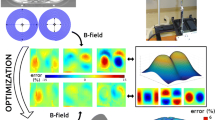Abstract
A simulated model of a commercial transcranial magnetic stimulation (TMS) coil is analyzed to determine electromagnetic field (EMF) exposure for an operator while holding or adjusting the coil. Induced EMF strengths are calculated using a commercial figure-8 coil geometry and pulse configuration, with geometrical representations of the subject’s head and the operator’s head, torso, and hand. Exposure levels are compared to experimental results in the literature and international guidelines for occupational EMF exposure limits. Exposure limit guidelines of 0.8 V/m rms are exceeded at approximately 24.6 cm from the coil for the torso model and at 20.3 cm for the head model measured perpendicular to the plane of the coil. In the plane of the coil, the operator can approach closer without exceeding guidelines. The results in the hand model along the edge of the coil give 9.9 V/m and 88.5 V/m for average and peak field strength, respectively. A discussion of the potential consequences of operator exposure to fields exceeding published guidelines concludes that since the guidelines are only concerned with acute effects and do not suggest any potential chronic effects, occupational exposure in the context of delivering TMS treatment may be considered reasonable.

A model of an operator’s head/torso was moved in space relative to a standard TMS coil and subject. Positions at which safety guidelines are exceeded were calculated. The maximum induced electric field was also calculated in a hand model placed in a position commonly used to hold TMS coils during treatments.






Similar content being viewed by others
References
Rossi S, Hallett M, Rossini PM, Pascual-Leone A, Safety of TMS Consensus Group (2009) Safety, ethical considerations, and application guidelines for the use of transcranial magnetic stimulation in clinical practice and research. Clin Neurophysiol 120:2008–2039. https://doi.org/10.1016/j.clinph.2009.08.016
International Commission on Non-Ionizing Radiation Protection (2003) Guidance on determining compliance of exposure to pulsed and complex non-sinusoidal waveforms below 100 kHz with ICNIRP guidelines. Health Phys 84:383–387
Directive EU (2004) Directive 2004/40/EC of the European Parliament and of the Council of 29 April 2004 on the minimum health and safety requirements regarding the exposure of workers to the risks arising from physical agents (electromagnetic fields). Eighteenth individual D. Off J Eur Union L159:1–26
Karlström EF, Lundström R, Stensson O, Mild KH (2006) Therapeutic staff exposure to magnetic field pulses during TMS/rTMS treatments. Bioelectromagnetics 27:156–158. https://doi.org/10.1002/bem.20194
Bottauscio O, Zucca M, Chiampi M, Zilberti L (2016) Evaluation of the electric field induced in transcranial magnetic stimulation operators. IEEE Trans Magn 52:1–4. https://doi.org/10.1109/TMAG.2015.2489561
Zucca M, Bottauscio O, Chiampi M, Zilberti L (2017) Operator safety and field focality in aluminum shielded transcranial magnetic stimulation. IEEE Trans Magn 53:1–4. https://doi.org/10.1109/TMAG.2017.2709402
Cincotta M, Giovannelli F, Borgheresi A, Balestrieri F, Toscani L, Zaccara G, Carducci F, Viggiano MP, Rossi S (2010) Optically tracked neuronavigation increases the stability of hand-held focal coil positioning: evidence from “transcranial” magnetic stimulation-induced electrical field measurements. Brain Stimul 3:119–123. https://doi.org/10.1016/j.brs.2010.01.001
International Commission on Non-Ionizing Radiation Protection (2010) Guidelines for limiting exposure to time-varying electric and magnetic fields (1 Hz TO 100 kHz). Health Phys 99:818–836. https://doi.org/10.1097/HP.0b013e3181f06c86
Directive EU (2013) Directive no. 2013/35/EU, of 26 June 2013, on the minimum health and safety requirements regarding the exposure of workers to the risks arising from physical agents (electromagnetic fields). Off J Eur Union L179:1–21
Li H, Ruan J, Xie Z et al (2007) Investigation of the critical geometric characteristics of living human skulls utilising medical image analysis techniques. Int J Veh Saf 2:345. https://doi.org/10.1504/IJVS.2007.016747
Lew S, Wolters CH, Anwander A et al (2009) Improved EEG source analysis using low-resolution conductivity estimation in a four-compartment finite element head model. Hum Brain Mapp 30:2862–2878. https://doi.org/10.1002/hbm.20714
Riches SF, Collins DJ, Charles-Edwards GD, Shafford JC, Cole J, Keevil SF, Leach MO (2007) Measurements of occupational exposure to switched gradient and spatially-varying magnetic fields in areas adjacent to 1.5T clinical MRI systems. J Magn Reson Imaging 26:1346–1352. https://doi.org/10.1002/jmri.21139
Davey K, Epstein CM (2000) Magnetic stimulation coil and circuit design. IEEE Trans Biomed Eng 47:1493–1499. https://doi.org/10.1109/10.880101
International Commission on Non-Ionizing Radiation Protection (1998) ICNIRP guidelines for limiting exposure to time-varying electric, magnetic and electromagnetic fields (up to 300 Ghz). Health Phys 74:494–522. https://doi.org/10.1097/HP.0b013e3181f06c86
Nyenhuis JA, Bourland JD, Kildishev A V, Schaefer DJ (2001) Health effects and safety of intense gradient fields. In: Shellock F (ed) Magnetic resonance procedures: health effects and safety. oca Raton, CRC Press, pp 31–54
So PPM, Stuchly MA, Nyenhuis JA (2004) Peripheral nerve stimulation by gradient switching fields in magnetic resonance imaging. IEEE Trans Biomed Eng 51:1907–1914. https://doi.org/10.1109/TBME.2004.834251
Keevil SF, Lomas DJ (2013) The European Union Physical Agents (Electromagnetic Fields) Directive: an update for the MRI community. Br Inst Radiol 86:20130492. https://doi.org/10.1259/bjr.20130492
Acknowledgments
COMSOL software licenses were provided through a CMC Microsystems subscription.
Funding
Financial support was received from the Natural Sciences and Engineering Council of Canada (NSERC).
Author information
Authors and Affiliations
Corresponding author
Ethics declarations
Conflict of interest
The authors declare that they have no conflict of interest.
Additional information
Publisher’s note
Springer Nature remains neutral with regard to jurisdictional claims in published maps and institutional affiliations.
Rights and permissions
About this article
Cite this article
Rutherford, G., Lithgow, B. & Moussavi, Z. Transcranial magnetic stimulation safety from operator exposure perspective. Med Biol Eng Comput 58, 249–256 (2020). https://doi.org/10.1007/s11517-019-02084-w
Received:
Accepted:
Published:
Issue Date:
DOI: https://doi.org/10.1007/s11517-019-02084-w




